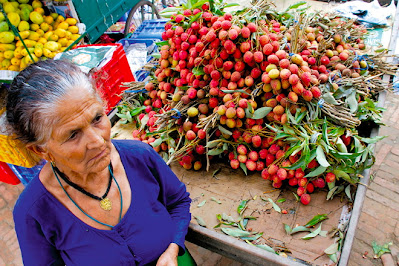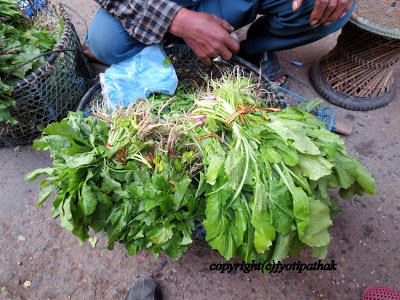Dattaraya Square was crowded as we went through to find a place for lunch on the first day of Makar Sankranti. This five week festival is in honor of Lord Shiva and when a person prays to Shiva during this auspicious month it is surely to be met with favor. Each Monday for the next four weeks women will go to the temple to pray for a husband with the qualities of Shiva, and for those who are already married, they wish for a long life for their husbands.
We had lunch at De Square Restaurant. Although a bit pricy for me, and always a disappointment, it has a great view of the temple. As I looked down I could see women standing in a very long line with their dishes of offerings. They were mostly dressed in lovely new, red sarees for the festival. The women all wear red clothing with green jewelry for prosperity, with the exception of widows.

I could also see some serious shopping going on below. A crowd of women were looking at fabric to make the traditional kurta. I was intrigued. I had seen these venders come in with some pretty good stuff at times so after lunch we decided to have a look. As I started shopping a local, Newari merchant friend came along and helped me. When I inquired at the first stall the price was 800 and 1,000, which obviously included my share of white tax. The other vender was much better and offered it to me at the local price, 550-650 NRs. I was surprised and elated by the lovely fabrics and my friend and the other women helped me to select four fabrics. Nepali women seem to get a kick out of just seeing me buy and wear their native dress. All four fabrics cost only 2,300 NRs.

Tip from book: Speaking of the local clothing, depending on the fabric, a person could get a lovely pajama made and wear it while you are here as a kurta and then as pajamas back home. Particularly in the fall season, a person could have a nice flannel set made for under $10 and have a nice souvenir to enjoy for many years. To avoid buying fabric that needs to be ironed, take a bit of fabric and crinkle it in your hand. When you let go you will have an idea about how wrinkle resistant the fabric is.
The problem with many festivals is there isn’t always something much more exciting than watching women wait for a chance at an audience with God. That is an incredible thing to think about and it is incredible, but it doesn’t look so incredible to watch. Be sure to ask at the Tourist Bureau (Ratna Park) or the tourist office at Darbur Square in Kathmandu, or the ticket office at Bhaktapur or UNESCO site to see what might be more interesting. These things are free and sometimes you will see something really amazing that you will be talking about for many years. For example, a few months ago during a celebration the chariot fell and crushed someone. One day my assistant, Deependra, and I were in the square when a little tuk tuk came by with the most amazing thing inside. It was a six legged cow! Everyone was worshipping it as a god-including me.

When I went upstairs to visit a temple found the women there to be very interested in encouraging me to embrace Hinduism. Although they didn’t speak English well, they showed me the temple, walked around it with me and then gave me a tika, the red mark on one’s forehead. The tika is an interesting concept. It is to be placed over the ‘third eye’ and symbolizes the god within. The love and regard that the women showed me, particularly by the one with the green necklace, is a real tribute to their faith. In Hinduism, conversion is seldom an issue and one’s religion is a matter of personal conscience. It seems to be a problem for the handful of Christians here more than for anyone else. It seems to be only the Christians that insist upon conversion or disallow marriage to people of other religions.

I assumed this was a Shiva temple, but when I saw the idol I turned to my new friends and asked, “Not Shiva?” Oh, no, this temple is for, Bhimsen, another Hindu god. This temple is directly across from the Dattaraya Temple.
Another tradition you will notice is the hand painting, called ‘mindi’, they do during certain festivals. Last year I had a great time at one of these festivals and had an artist paint me some wild eyebrows and a bindi. Then my assistant and I went to Pashapatinath.
On this particular day, our next stop was the nearby Natumahadev Temple, which is located just outside Bhaktapur-a less crowded Shiva Temple. I met such a lovely young woman and her mother there. You see, in Nepal there is a person who takes care of each temple. When that person dies the family continues to live there and that is who these women are, the grounds keepers. They are very poor and only subsist on what people offer them or leave at the temple. As you can see, this temple grounds is a lot to care for when there is no lawn mower or electric tools.

This is Lord Budhalinkantha in the pokhari. This idol is a replica of a statue that emerged from the ground, as is the case with many of the gods in Nepal. The idol that emerged in Kathmandu of Lord Budhalinkantha is the largest idol of him. You can take a look at the huge idol in Kathmandu, in the Narayanthan area. This temple was erected at the very site that the idol was found and is a free temple with this idol viewable, but only Hindus can go into the temple to touch it. Now, what I find amazing about this is that no one claimed ownership of it. These idols come out of the dirt as the farmers are tending their fields. They are from very ancient times and no one seems to know how or why they were buried. There doesn’t seem to be a time when the Kathmandu Valley was abandoned by the inhabitants. So, how does a person loose a huge stone statue? This is a phenomenon that is responsible for many of the temples you will see today.
These festivals are often the highpoint of a tourist’s visit here and I highly recommend that you make an effort to participate in at least one festival while you are here. Keep in mind that most major festivals take place during the full moon, so take note of whether or not there is going to be a full moon during your time in Nepal.
Did you know I wrote an eBook filled with tips on getting the most out of your visit to Nepal?
Satisfaction Guaranteed: NO FINE PRINT. If you don't truly love Nepal: A Tourist’s Manual, please send for 100% money back. If you are not completely satisfied just send your purchase information along with a note to: FrugalTravelsNepal@gmail.com
Nepal: A Tourist’s Manual-For more information check out our website. If you enjoy this blog and the website you will enjoy the 299 page eBook. It is a well illustrated, easy read with over 1,000 tips to help you get the most out of Nepal.
Visit my website:
Nepal: A Tourist's Manual



.jpg)












Wonderful blog! The festival Makar Sankranthi is a harvest festival for Hindus and is quite popular in Maharashtra, Karnataka. Here are some innovative Makar Sankranti celebration ideas to add fun to your celebrations.
ReplyDelete